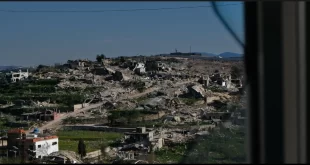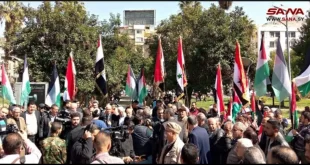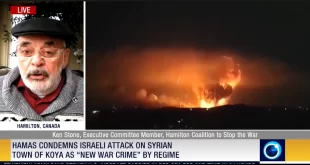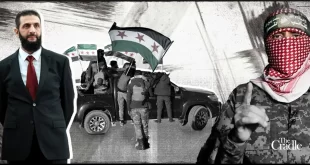SOTT.net 1 April 2016 (Global Research)
-Eva Bartlett
The recent liberation of Syria’s Palmyra (a UNESCO world Heritage site) by the Syrian Arab Army (SAA) and allies is an important victory for numerous reasons. Not only does it send yet another message to the different Western-backed terrorist factions (which Syria has been fighting for the past five years) that they will eventually fall, but it also sends a message to the West and their gang of anti-Syrian states and actors – who have been fuelling this savage war on a sovereign Syria – that Syria and Syrians remain resilient, the SAA and allies remain relentless in their fight against terrorism, and that Syria’s political allies continue to support her.
Further, the victory once again dispels the myth of “Assad’s army brutalizing the people”: footage from inside the liberated city of Palmyra shows residents praising President al-Assad and praising the Syrian Arab Army (a reported 200 of whom were killed in the battle to liberate Palmyra), much like footage from the liberated villages of Nubl and al-Zahra’a earlier this year, and every area, in fact, which the army has secured.
During Da’esh (ISIS) terrorists’ occupation of Palmyra, they blew up and destroyed numerous historic sites and brutally decapitated 82-year-old archaeologist Khaled al-Asaad. Ironically, while corporate media now twists the facts and alleges Syrian responsibility for the entry of Da’esh into Palmyra, they turn permanently-blinded eyes to the fact that the US-led coalition supposedly fighting Da’esh somehow, with all of their state-of-the-art technology, missed the convoy of Da’esh terrorists moving through vast stretches of open desert to reach Palmyra.
Now that the area is secured, Syrians can begin an assessment of the extent of damage to Palmyra. The Director General of Antiquities and Museums Directorate (DGAM) on March 27 issued a statement, which including the following:
“…we promise to restore the city as it used to be, in a cultural and intellectual message opposite to the destruction and terror, so the city will again represent the tolerance and multicultural richness that Palmyra has had through history…”
Restoration will need time and peace, but it is praiseworthy that some restoration in other liberated sites (Ma’aloua, old Homs, Krak des Chevaliers) has occurred while Syria is fighting the disease of Western-Gulf-Zionist-Turkish-inflicted terror.
Concerns over the fate of Palmyra were not exclusive to Syria’s DGAM, but also to the Ministry of Tourism (MOT), the work of which includes far more than merely promoting Syria’s touristic sites.
In a December 2015 meeting, Tourism Minister Besher Yazji spoke to me of Palmyra, the overall situation in Syria, and MOT initiatives to not only boost the Syrian economy – devastated by sanctions and war – but also the morale of Syrians and the image of Syria, which has been transformed by events over the past 5 years, and the corporate media’s distorted reporting:
“The heart of many civilizations is Palmyra. It’s not surprising that Saudi (Arabia) and Gulf states do not care about the destruction of Syria’s ancient ruins, because they don’t have civilizations in the first place. But what is sad is that Europeans, or other countries which have civilizations, they are not doing anything to help us. Politicians like François Hollande are purchased with Gulf money.”
Not only are they not helping Syria to preserve its heritage, many Western nations, including France, are overtly or covertly supporting the terrorists destroying Syria.
In February 2015, I wrote about the destruction of Syria’s heritage, noting the DGAM’s plea:
“A year has passed since we last sent an international call out to all those concerned with defending Syria’s heritage. At the time, we warned against a possible cultural disaster that might be inflicted on an invaluable part of the human heritage existing in Syria.”
As Minster Yazji alluded, the West ignored this call, ignored UNESCO warnings and Syria’s pleas, and additionally – and hypocritically – threw blame at the Syrian government.
Ministry of Tourism Work Increased
Minister Yazji remarked that, to some outside of Syria, the importance of a tourism ministry might seem odd at this time.
Indeed Western corporate journalists have on numerous occasions mocked the MOT’s campaigns, ignoring the role the campaigns play with respect to Syria’s devastated economy, and also for the morale of the Syrian people, exhausted by years of life under foreign war.
Some Western commentators seem to think that Syrians should not be allowed to enjoy cultural events, hold festivals, or travel in their own country for the love of it. The arrogance of such assumptions aside, the numerous Syrian groups and individuals that do just those things defy such assumptions. In areas not 100% under the assault of Western-backed terrorists, not besieged like al-Foua and Kafarya or infested by terrorists as in Raqqa or Deiz ez Zor, Syrians do in fact celebrate, travel, and get on with life as much as possible.
This doesn’t render trivial the suffering of Syrians in troubled areas, but the notion that Syrians should just stay at home and not enjoy their culture or celebrate their country, is again arrogant and a notion that only someone who has never endured years of war could put forth. Additionally, when they have the opportunity to travel elsewhere in Syria, even Syrians living or serving in difficult areas act as tourists, as anyone would.
Nonetheless, even I was surprised when Minister Yazji said: “The work in the Ministry has doubled since before the crisis, when we had safety.”
Given that Syria’s tourism economy has plummeted dramatically over the years since the start of the foreign war on Syria, decimating that sector of the economy and taking countless jobs related to tourism with it, you might have thought that the work of the Tourism Ministry would be almost non-existent.
In fact, it is due to the combination of the war on Syria, and to the propaganda war against Syria, that the Ministry is busy:
“We are subjected to media terrorism, it has defaced Syria’s image. Syria’s image has become associated only with war. That’s why our work here has doubled. Our job is to restore the true image of Syria—not a dressed up image, but one of how the Syrian people are living, how they are suffering from terrorism, but also how our country is beautiful still.”
Religious Tourism and Investment Markets
“Syria is well-known for its mosques, churches, temples, holy shrines, and other religious sites,” Minister Yazji told me. “Even now, there are over 300,000 reservations in Sayyida Zainab alone, with religious tourists flying in from various Gulf states, Iran, England, India and Pakistan.”
“Investing in tourism is difficult in safe periods, but during a time of war, it might come as a surprise that there is any investment. Yet, there have been high demands on hotels in Syria during the summer and during the last two seasons. Accordingly, there were many Syrian investors wanting to make new projects here. During 2015, 87 new tourist venues opened, including 8 new hotels: one 4-star and the rest 3-star. The other venues were restaurants and cafes, located in Homs, Latakia, Tartous, and Sweida.”
A press release from the MOT website noted that their priorities for 2011 and on included the Old City of Aleppo, Palmyra, the Old City of Damascus, and the Umayyad Mosque of Damascus, “one of the largest and oldest mosques in the world. Located in one of the holiest sites in the old city of Damascus, it is of great architectural importance, and one of the most important mosques for Muslims from all over the world. The mosque holds a shrine containing the head of John the Baptist, honored as a prophet by Muslims and Christians alike…”
Sadly, these areas meant to be highlighted as tourist destinations are the ones which have been most heavily hit, vandalized, looted, and damaged during the last five years of the global war on Syria.
As I wrote in my February 2015 article:
“Terrorists’ car bombs and mortars, which have terrorized residents of the city (Damascus), have also hit historic places. The 11th-century Citadel, the 8th-century Umayyad Masjid, the 13th-century Great Madrasah, al-Adliya, the Greek Orthodox Church of Antioch in Bab Touma, and the Armenian Orthodox Church in Bab Sharqi, have all suffered, according to UNESCO’s report.
The Aleppo section of UNESCO’s latest “Damage Assessment Overview” is lengthy. Some of the assessment includes:
- “At least 121 historical buildings have been damaged or destroyed — equal to 30-40% of the World Heritage property area — in addition to the destruction of more than 1,500 shops of the Suq.”
- “The 11th century Minaret, the prayer hall, and the main gate of the Omayyad Masjid have been destroyed….”
- “Terrorists from the Islamic Front exploded the 150-year-old Carlton Citadel Hotel in Aleppo’s Old City in May 2014, the destruction and damage extending to the 13th-century Citadel facing the hotel.”
My February 2015 article also noted al-Nusra and so-called “Free Syrian Army” (FSA) terrorists’ destruction and looting in historic Ma’aloua, the Old City of Homs (with numerous ancient churches), and elsewhere in Syria.
This vandalism, theft and destruction impacts Syria’s economy, heritage, and future tourism.
Artists and Artisans
Aleppo has not only been the site of terrorist infiltration and mortar and rocket attacks on civilian areas, but its factories have been plundered by the West’s “moderates” and taken to Turkey. The resulting economic suffering in Aleppo is immense.
One of the MOT’s points of focus, throughout Syria but including Aleppo, are exhibitions highlighting the work of independent artists.
“We had an exhibition for women from Aleppo in which over 120 women participated, from the chambers of commerce and industry. Among them were businesswomen, but also women who started working during this crisis, to compensate for the loss of work or businesses of their husbands. Their work demanded a high level of technique, and at the same time there were many very creative ideas.”
The effects of the war on Syria have impacted on artisans and shop owners, leaving their shops devoid of tourist customers or simply closed down. Minister Yazdi said:
“Many traditional shops and markets were completely destroyed, especially in Aleppo and in Damascus in the Bab Sharqi (East Gate) district, where many of the shops were damaged and destroyed from the mortars. The government is trying to support artisans by giving them new shops and training them. The Syria Trust for Development provides them with training and the materials they need.
Some artists are already exporting, but we are supporting many others in doing so. There are, for example, people in the Gulf states who want chairs inlaid with shells. Bay leaf soap, produced in Aleppo, is now being exported to France. We encourage them to have their own websites. Some of them are on social media, like Facebook and Twitter.”
‘I Belong’ and ‘Creative City’ Campaigns
One of UNESCO’s initiatives is that of the ‘Creative Cities Network’, including ”116 Members from 54 countries covering seven creative fields: Crafts & Folk Art, Design, Film, Gastronomy, Literature, Music and Media Arts.”
Syria’s MOT is working on adding Damascus to that network:
“The file we are working on is Syrian traditional handicrafts and folklore, including Damascene glass, the brocade fabric, Aghabanitextiles, copper and Silver work, shells, mosaics.”
In doing so, this is one further way the MOT is trying to combat the effects of sanctions and war on Syria.
“Also, we have launched an initiative called ‘I belong’. The initiative is directed at Syrians living outside of Syria and for anyone who is heartbroken at the destruction of the terrorists, whether in Ibla and Mari, Palmyra, the souks in the Old City of Aleppo, or elsewhere. The initiative has two parts: financial support and moral support.
High quality miniature replicas have been made of historic sites in Syria. Revenues of the initiative will be used to support tourism sector and heritage sites in the country, and the rehabilitation of archeological sites. One of the icons that we made a replica of was one of the oldest peace treaties that exists, the Treaty of Kadesh, found in Ibla. We also focus on Ma’aloula, and are preparing something on Palmyra.
They will be available for Syrians around the world, with a certificate of thanks/recognition, including a serial number associated with each replica, to assure the buyer that the money is going to a safe place/towards this project.”
After over five years of this bloody war on Syria, Syrians defy all projections and instead of collapsing as per Western commentators’ expectations, Syrians continue to find creative means to support themselves, keep Syria’s heritage alive, and not be cowed by foreign intervention.
 Syria Support Movement solidarity with the Syrian people
Syria Support Movement solidarity with the Syrian people





